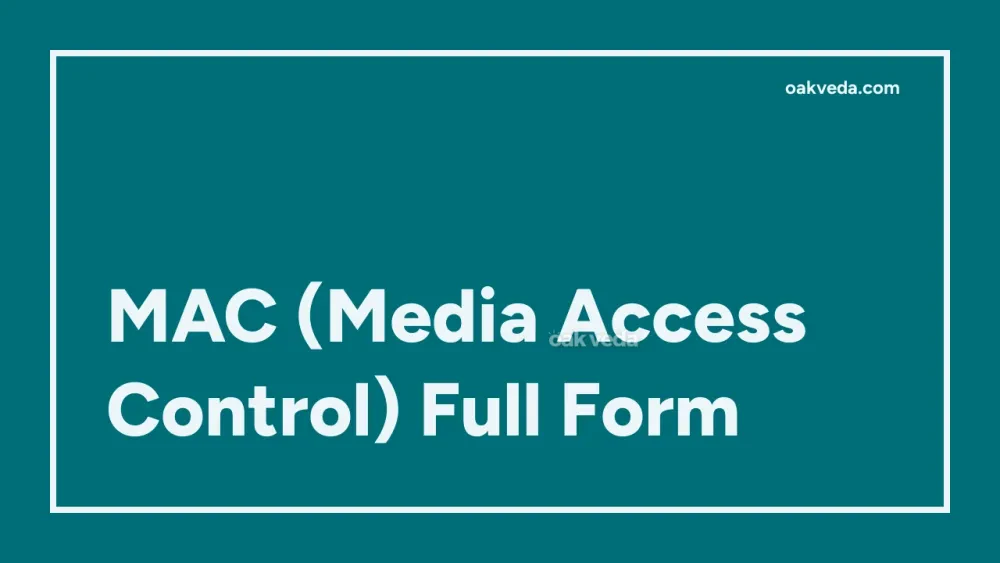
What is the Full Form of MAC?
The full form of MAC is Media Access Control. This term is widely used in the field of computer networking and telecommunications. MAC refers to a unique identifier assigned to network interface controllers (NICs) for use as a network address in communications within a network segment.
What is Media Access Control?
Media Access Control is a data communication protocol and sublayer of the Data Link Layer in the seven-layer OSI (Open Systems Interconnection) model. It provides addressing and channel access control mechanisms that enable multiple devices to communicate within a multi-point network, typically a local area network (LAN) or metropolitan area network (MAN).
Origin and Development of Media Access Control
The concept of MAC addresses and the Media Access Control protocol has its roots in the early development of computer networking:
- Researchers at Xerox PARC (Palo Alto Research Center) are credited with developing the initial concepts of MAC addresses in the 1970s.
- The IEEE (Institute of Electrical and Electronics Engineers) standardized MAC addresses as part of the IEEE 802 standards for local area networks.
- Over time, MAC addresses became an integral part of various networking technologies, including Ethernet, Wi-Fi, and Bluetooth.
How does Media Access Control work?
Media Access Control works by:
- Providing a unique identifier (MAC address) for each network interface.
- Controlling access to the physical network medium.
- Facilitating data transfer between devices on the same network segment.
- Enabling frame synchronization and error detection at the data link layer.
The MAC address, often referred to as the physical address or hardware address, is a 48-bit number typically represented as six groups of two hexadecimal digits (e.g., 00:1A:2B:3C:4D:5E).
Functions of Media Access Control
The primary functions of Media Access Control include:
- Addressing: Assigning unique identifiers to network devices.
- Frame delimiting and recognition: Marking the beginning and end of data frames.
- Error detection: Identifying transmission errors in received frames.
- Media access management: Controlling when devices can transmit data on shared networks.
Applications of Media Access Control
Media Access Control is applied in various networking scenarios:
- Ethernet networks
- Wi-Fi connections
- Bluetooth communications
- Network switching and routing
- Network access control and security
Features of Media Access Control
Key features of Media Access Control include:
- Uniqueness: Each MAC address is globally unique (with rare exceptions).
- Permanence: MAC addresses are typically fixed and assigned by manufacturers.
- Hardware-level identification: MAC addresses operate at the hardware level, independent of higher-level protocols.
- Local network scope: MAC addresses are used for communication within a local network segment.
Benefits of Media Access Control
The use of Media Access Control offers several advantages:
- Efficient network communication: Enables direct addressing of devices on a local network.
- Enhanced security: Allows for MAC address filtering to control network access.
- Simplified network troubleshooting: Helps in identifying specific devices on a network.
- Protocol independence: Works with various higher-level network protocols.
- Collision avoidance: Helps manage data transmission on shared network mediums.
Limitations or Challenges of Media Access Control
Despite its benefits, Media Access Control has some limitations:
- Address spoofing: MAC addresses can be spoofed, potentially compromising security.
- Limited scalability: The 48-bit address space may eventually be exhausted as the number of networked devices grows.
- Privacy concerns: MAC addresses can be used to track devices and potentially compromise user privacy.
- Management overhead: Large networks may require significant effort to manage MAC address-based policies.
Future Developments in Media Access Control Technology
As networking technology evolves, several developments are shaping the future of Media Access Control:
- Extended address space: Proposals for 64-bit or larger MAC addresses to accommodate more devices.
- Enhanced security: Integration of cryptographic techniques to prevent MAC address spoofing.
- Software-defined networking (SDN): New approaches to network management that may change how MAC addresses are used.
- Internet of Things (IoT): Adapting MAC protocols for the unique requirements of IoT devices and networks.
FAQs on MAC Full Form
-
What is the difference between a MAC address and an IP address? A MAC address is a hardware-level identifier assigned to a network interface, while an IP address is a logical address used for routing data across networks.
-
Can a MAC address be changed? While MAC addresses are typically fixed, some network interfaces allow for software-based MAC address changes, often called MAC address spoofing.
-
How many possible MAC addresses are there? With the current 48-bit format, there are theoretically 2^48 (approximately 281 trillion) possible MAC addresses.
-
Who assigns MAC addresses to manufacturers? The IEEE Registration Authority assigns blocks of MAC addresses to manufacturers.
-
Are MAC addresses used in all types of networks? MAC addresses are primarily used in Ethernet and IEEE 802 networks. Other network types may use different addressing schemes.
By understanding the full form of MAC and its role in networking, IT professionals and enthusiasts can better appreciate the fundamental mechanisms that enable modern digital communications.
You may be interested in:

